weight MERCEDES-BENZ G500 2002 W463 Owner's Manual
[x] Cancel search | Manufacturer: MERCEDES-BENZ, Model Year: 2002, Model line: G500, Model: MERCEDES-BENZ G500 2002 W463Pages: 385, PDF Size: 30.37 MB
Page 80 of 385
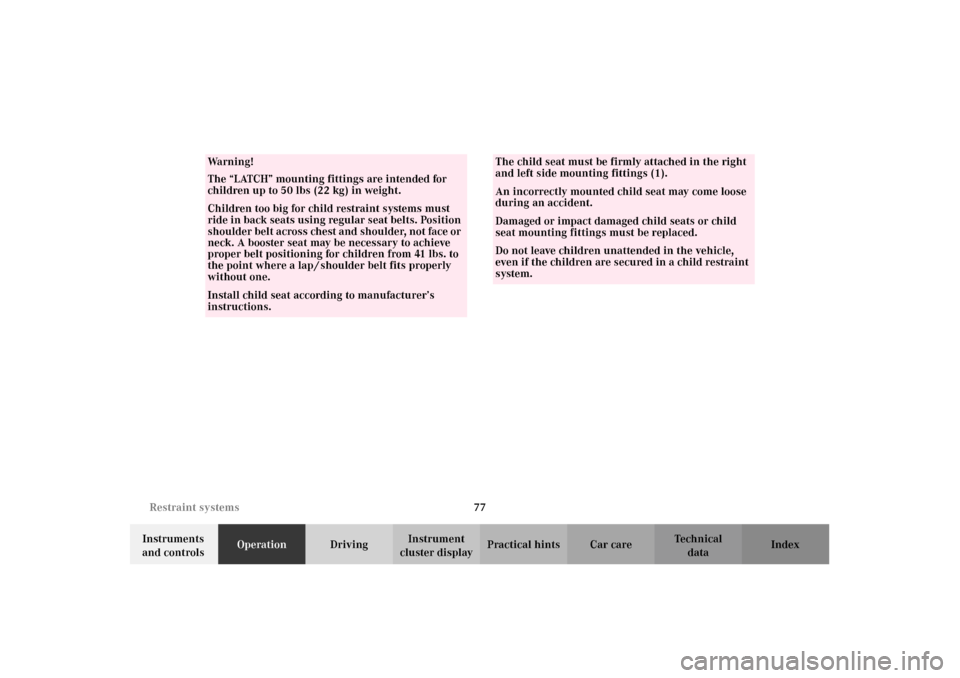
77 Restraint systems
Te ch n i c a l
data Instruments
and controlsOperationDrivingInstrument
cluster displayPractical hints Car care Index
Wa r n i n g !
The “LATCH” mounting fittings are intended for
children up to 50 lbs (22 kg) in weight.Children too big for child restraint systems must
ride in back seats using regular seat belts. Position
shoulder belt across chest and shoulder, not face or
neck. A booster seat may be necessary to achieve
proper belt positioning for children from 41 lbs. to
the point where a lap / shoulder belt fits properly
without one.Install child seat according to manufacturer’s
instructions.
The child seat must be firmly attached in the right
and left side mounting fittings (1).An incorrectly mounted child seat may come loose
during an accident.Damaged or impact damaged child seats or child
seat mounting fittings must be replaced.Do not leave children unattended in the vehicle,
even if the children are secured in a child restraint
system.
J_G463.book Seite 77 Mittwoch, 19. September 2001 8:06 08
Page 181 of 385
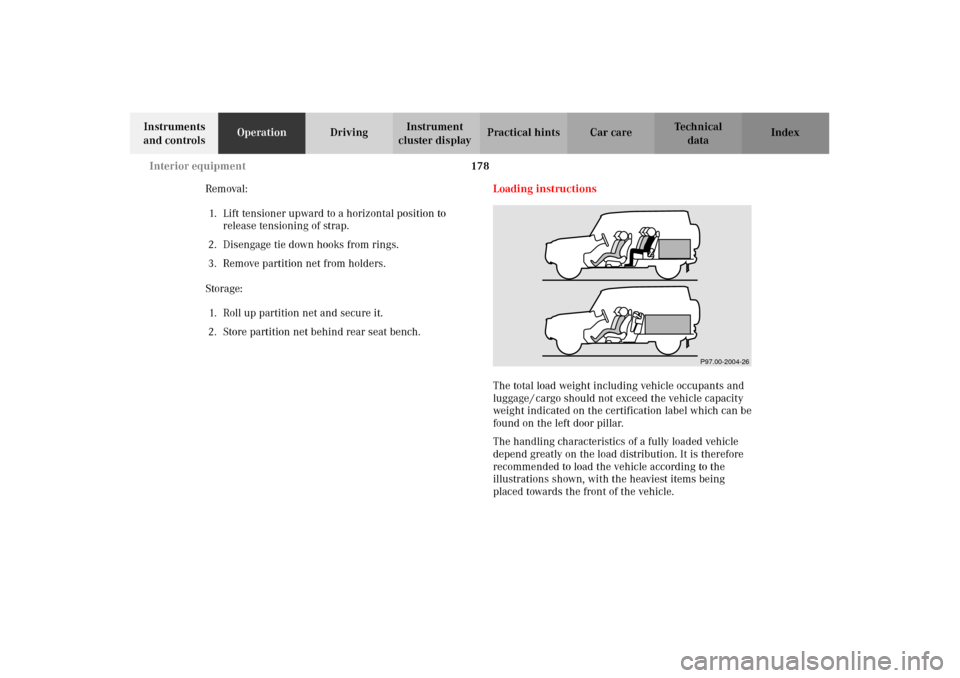
178 Interior equipment
Te ch n i c a l
data Instruments
and controlsOperationDrivingInstrument
cluster displayPractical hints Car care Index
Removal:
1. Lift tensioner upward to a horizontal position to
release tensioning of strap.
2. Disengage tie down hooks from rings.
3. Remove partition net from holders.
Storage:
1. Roll up partition net and secure it.
2. Store partition net behind rear seat bench.Loading instructions
The total load weight including vehicle occupants and
luggage / cargo should not exceed the vehicle capacity
weight indicated on the certification label which can be
found on the left door pillar.
The handling characteristics of a fully loaded vehicle
depend greatly on the load distribution. It is therefore
recommended to load the vehicle according to the
illustrations shown, with the heaviest items being
placed towards the front of the vehicle.
P97.00-2004-26
J_G463.book Seite 178 Mittwoch, 19. September 2001 8:06 08
Page 182 of 385
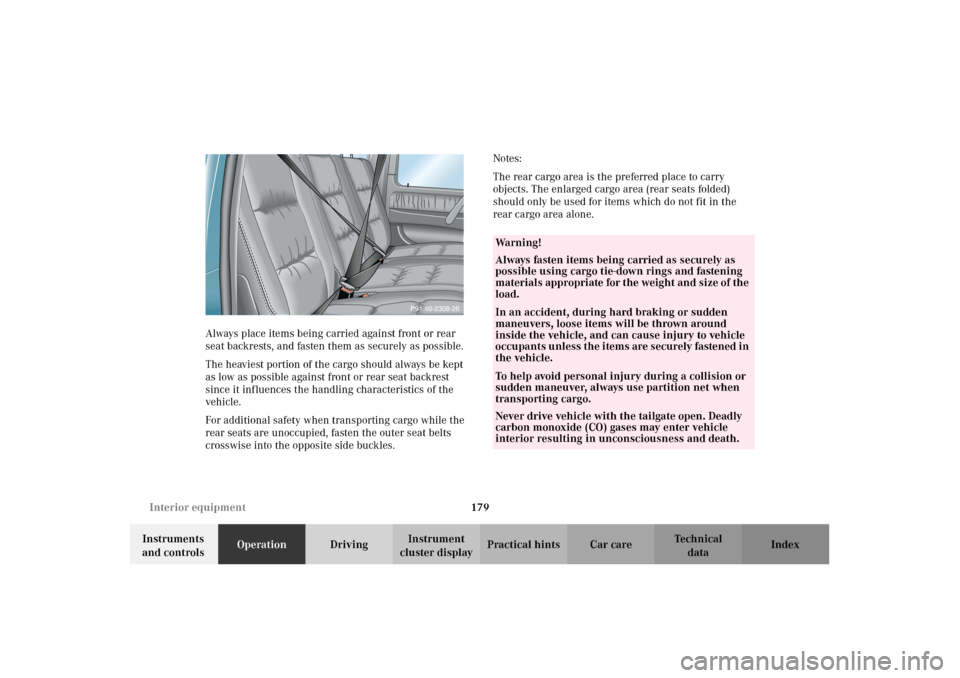
179 Interior equipment
Te ch n i c a l
data Instruments
and controlsOperationDrivingInstrument
cluster displayPractical hints Car care Index Always place items being carried against front or rear
seat backrests, and fasten them as securely as possible.
The heaviest portion of the cargo should always be kept
as low as possible against front or rear seat backrest
since it influences the handling characteristics of the
vehicle.
For additional safety when transporting cargo while the
rear seats are unoccupied, fasten the outer seat belts
crosswise into the opposite side buckles.Notes:
The rear cargo area is the preferred place to carry
objects. The enlarged cargo area (rear seats folded)
should only be used for items which do not fit in the
rear cargo area alone.
Wa r n i n g !
Always fasten items being carried as securely as
possible using cargo tie-down rings and fastening
materials appropriate for the weight and size of the
load.In an accident, during hard braking or sudden
maneuvers, loose items will be thrown around
inside the vehicle, and can cause injury to vehicle
oc cu pa nt s u nl ess t he i tem s are s ecurely fastened i n
the vehicle.To help avoid personal injury during a collision or
sudden maneuver, always use partition net when
transporting cargo.
Never drive vehicle with the tailgate open. Deadly
carbon monoxide (CO) gases may enter vehicle
interior resulting in unconsciousness and death.
J_G463.book Seite 179 Mittwoch, 19. September 2001 8:06 08
Page 232 of 385
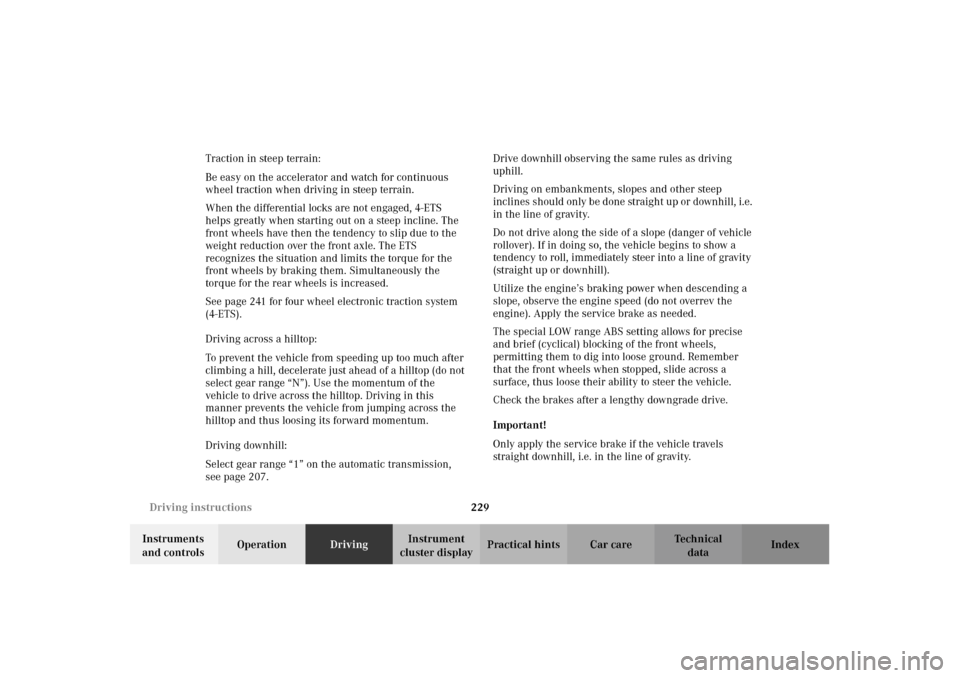
229 Driving instructions
Te ch n i c a l
data Instruments
and controlsOperationDrivingInstrument
cluster displayPractical hints Car care Index Traction in steep terrain:
Be easy on the accelerator and watch for continuous
wheel traction when driving in steep terrain.
When the differential locks are not engaged, 4-ETS
helps greatly when starting out on a steep incline. The
front wheels have then the tendency to slip due to the
weight reduction over the front axle. The ETS
recognizes the situation and limits the torque for the
front wheels by braking them. Simultaneously the
torque for the rear wheels is increased.
See page 241 for four wheel electronic traction system
(4-ETS).
Driving across a hilltop:
To prevent the vehicle from speeding up too much after
climbing a hill, decelerate just ahead of a hilltop (do not
select gear range “N”). Use the momentum of the
vehicle to drive across the hilltop. Driving in this
manner prevents the vehicle from jumping across the
hilltop and thus loosing its forward momentum.
Driving downhill:
Select gear range “1” on the automatic transmission,
see page 207.Drive downhill observing the same rules as driving
uphill.
Driving on embankments, slopes and other steep
inclines should only be done straight up or downhill, i.e.
in the line of gravity.
Do not drive along the side of a slope (danger of vehicle
rollover). If in doing so, the vehicle begins to show a
tendency to roll, immediately steer into a line of gravity
(straight up or downhill).
Utilize the engine’s braking power when descending a
slope, observe the engine speed (do not overrev the
engine). Apply the service brake as needed.
The special LOW range ABS setting allows for precise
and brief (cyclical) blocking of the front wheels,
permitting them to dig into loose ground. Remember
that the front wheels when stopped, slide across a
surface, thus loose their ability to steer the vehicle.
Check the brakes after a lengthy downgrade drive.
Important!
Only apply the service brake if the vehicle travels
straight downhill, i.e. in the line of gravity.
J_G463.book Seite 229 Mittwoch, 19. September 2001 8:06 08
Page 304 of 385
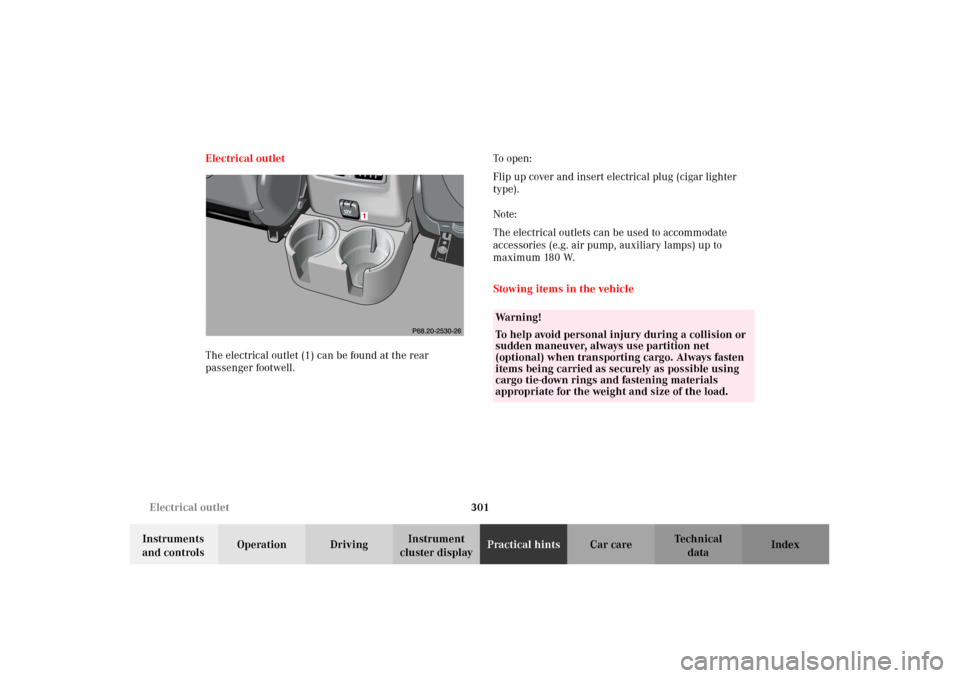
301 Electrical outlet
Te ch n i c a l
data Instruments
and controlsOperation DrivingInstrument
cluster displayPractical hintsCar care Index Electrical outlet
The electrical outlet (1) can be found at the rear
passenger footwell.To o p e n :
Flip up cover and insert electrical plug (cigar lighter
type).
Note:
The electrical outlets can be used to accommodate
accessories (e.g. air pump, auxiliary lamps) up to
maximum 180 W.
Stowing items in the vehicle
Wa r n i n g !
To help avoid personal injury during a collision or
sudden maneuver, always use partition net
(optional) when transporting cargo. Always fasten
items being carried as securely as possible using
cargo tie-down rings and fastening materials
appropriate for the weight and size of the load.
J_G463.book Seite 301 Mittwoch, 19. September 2001 8:06 08
Page 322 of 385
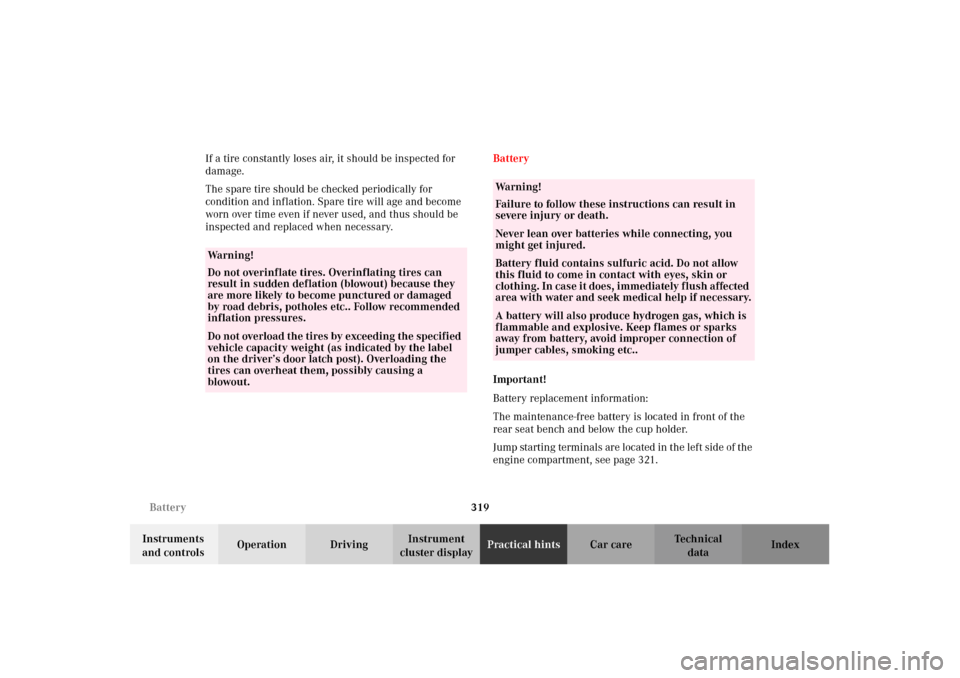
319 Battery
Te ch n i c a l
data Instruments
and controlsOperation DrivingInstrument
cluster displayPractical hintsCar care Index If a tire constantly loses air, it should be inspected for
damage.
The spare tire should be checked periodically for
condition and inflation. Spare tire will age and become
worn over time even if never used, and thus should be
inspected and replaced when necessary.Battery
Important!
Battery replacement information:
The maintenance-free battery is located in front of the
rear seat bench and below the cup holder.
Jump starting terminals are located in the lef t side of the
engine compartment, see page 321.
Wa r n i n g !
Do not overinflate tires. Overinflating tires can
result in sudden deflation (blowout) because they
are more likely to become punctured or damaged
by road debris, potholes etc.. Follow recommended
inflation pressures.Do not overload the tires by exceeding the specified
vehicle capacity weight (as indicated by the label
on the driver’s door latch post). Overloading the
tires can overheat them, possibly causing a
blowout.
Wa r n i n g !
Failure to follow these instructions can result in
severe injury or death.Never lean over batteries while connecting, you
might get injured.Battery fluid contains sulfuric acid. Do not allow
this fluid to come in contact with eyes, skin or
clot hin g. In cas e i t d oes , i mm ed ia tely f lus h a f fected
area with water and seek medical help if necessary.A battery will also produce hydrogen gas, which is
flammable and explosive. Keep flames or sparks
away from battery, avoid improper connection of
jumper cables, smoking etc..
J_G463.book Seite 319 Mittwoch, 19. September 2001 8:06 08
Page 363 of 385
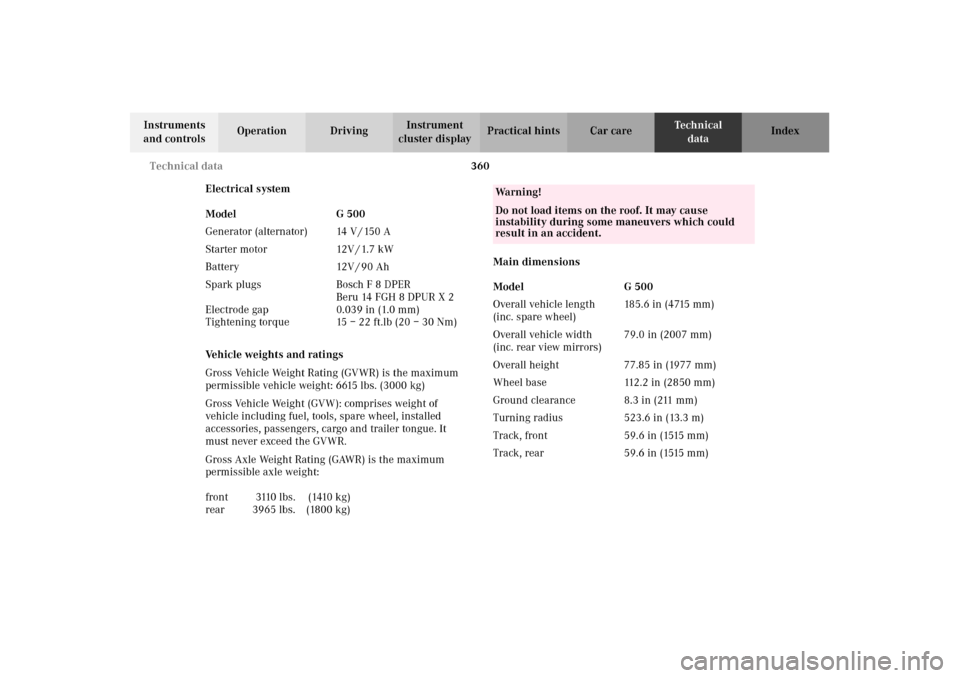
360
Technical \fata
Te ch n i c a l
\fata
In\btrument\b
an\f control\b Operation Driving
In\btrument
clu\bter \fi\bplay Practical hint\b Car care In\fex
Electrical \by\btem
Vehicle weight\b an\f rating\b
Gr\fss Vehicle Weight Rating (GVWR) is the maximum
\bermissible vehicle weight: 6615 lbs. (3000 kg)
Gr\fss Vehicle Weight (GVW): c\fm\brises weight \ff
vehicle including fuel, t\f\fls, s\bare wheel, installed
access\fries, \bassengers, carg\f and trailer t\fngue. It
must never exceed the GVWR.
Gr\fss Axle Weight Rating (GAWR) is the maximum
\bermissible axle weight: Main \fimen\bion\b
Mo\fel G 500
Generat\fr (alternat\fr) 14 V / 150 A
Starter m\ft\fr 12V / 1.7 kW
B
att ery 12 V /9 0 A h
S\bark \blugs
Electr\fde ga\b
Tightening t\frque B\fsch F 8 DPER
Beru 14 FGH 8 DPUR X 2
0.039 in (1.0 mm)
15–22ft.lb (20–30Nm)
fr\fnt
rear 3110 l b s .
3965 lbs. ( 1410 k g )
(1800 kg)
Wa r n i n g !Do not loa\f item\b on the roof. It may cau\be
in\btability \furing \bome maneuver\b which coul\f
re\bult in an acci\fent.
Mo\fel G 500
Overall vehicle length
(inc. s\bare wheel) 185.6 in (4715 mm)
Overall vehicle width
(inc. rear view mirr\frs) 79.0
in (2 007 m m)
O ver all h eig h t 77.85 i n ( 1 9 77 m m )
Wheel base 112.2 in (2850 mm)
Gr\fund clearance 8.3 in (211 mm)
Turning radius 523.6 in (13.3 m)
Track, fr\fnt 59.6 in (1515 mm)
Track, rear 59.6 in (1515 mm)
J_G463.book Seite 360 Mittwoch, 19. September 2001 8:06 08
Page 381 of 385
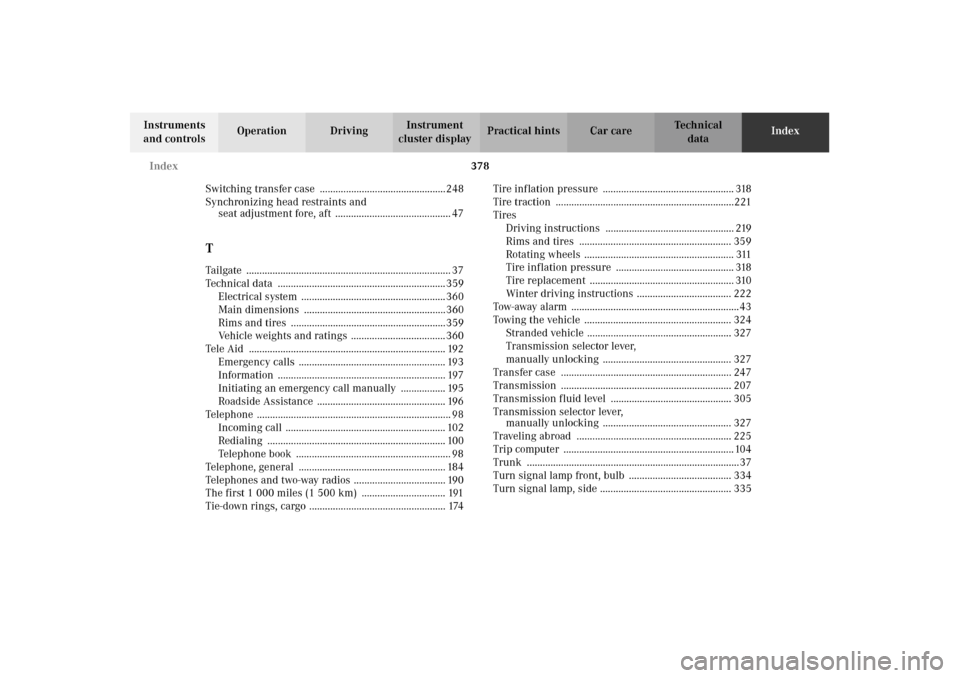
378 Index
Te ch n i c a l
data Instruments
and controlsOperation DrivingInstrument
cluster displayPractical hints Car careIndex
Switching transfer case ................................................248
Synchronizing head restraints and
seat adjustment fore, aft ............................................ 47
TTailgate .............................................................................. 37
Technical data ................................................................ 359
Electrical system ....................................................... 360
Main dimensions ......................................................360
Rims and tires ...........................................................359
Vehicle weights and ratings .................................... 360
Tele Aid ........................................................................... 192
Emergency calls ........................................................ 193
Information ................................................................ 197
Initiating an emergency call manually ................. 195
Roadside Assistance ................................................. 196
Telephone .......................................................................... 98
Incoming call ............................................................. 102
Redialing .................................................................... 100
Telephone book ........................................................... 98
Telephone, general ........................................................ 184
Telephones and two-way radios ................................... 190
The first 1 000 miles (1 500 km) ................................ 191
Tie-down rings, cargo .................................................... 174Tire inflation pressure .................................................. 318
Tire traction ....................................................................221
Tires
Driving instructions ................................................. 219
Rims and tires .......................................................... 359
Rotating wheels ......................................................... 311
Tire inflation pressure ............................................. 318
Tire replacement ....................................................... 310
Winter driving instructions .................................... 222
Tow-away alarm ................................................................43
Towing the vehicle ........................................................ 324
Stranded vehicle ....................................................... 327
Transmission selector lever,
manually unlocking ................................................. 327
Transfer case ................................................................. 247
Transmission ................................................................. 207
Transmission fluid level .............................................. 305
Transmission selector lever,
manually unlocking ................................................. 327
Traveling abroad ........................................................... 225
Trip computer ................................................................. 104
Trunk .................................................................................37
Turn signal lamp front, bulb ....................................... 334
Turn signal lamp, side .................................................. 335
J_G463.book Seite 378 Mittwoch, 19. September 2001 8:06 08